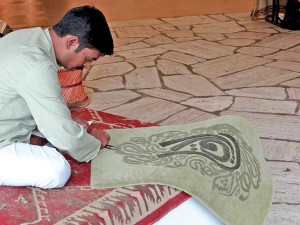
Known globally as the ‘Paradise on Earth’, Kashmir is as much famous for its rich heritage of exquisite arts and crafts as for its scenic beauty and bracing climate. A diverse range of high-end articles varying from textile products to floor coverings to handicrafts can be easily spotted in international retail at outlets like Harrods, Macy’s, John Lewis, Saks Fifth Avenue, Anthropology, Blooming Dales, Debenhams, Selfridges, Robert Elan, TJ Maxx, Williams-Sonoma to mention a few. In the first half of 2013-14, export of Kashmiri home décor products jumped by 130 per cent, from Rs. 112.88 crore to Rs. 598.70 crore giving great thrust for future business. Upbeat on the positive figures, Handicrafts Directorate of Kashmir now anticipates annual exports for 2013-14 to cross Rs. 20,000 crore.
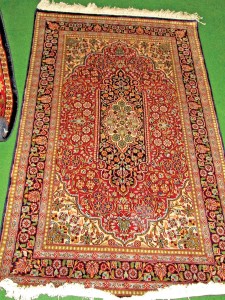
Sophistication of colours, design and precision of execution are common features in the entire range of home textile and handicrafts made in Kashmir, which includes woollen textile with fleece-like soft feel and woven intricate textures, range a magnificent made-ups with crewel work embroidery, super-fine hand-knotted silk carpets, cushion covers, bed covers, cotton and wool rugs, to exquisitely designed papier-mâché and silverware. “Year 2012 was a damper with exports from Kashmir falling by Rs. 112.88 crores, but this year significant gains in export of carpets, chainstitch rugs and crewel work products have been witnessed,” says Mushtaq Ahmad, Assistant Director, Directorate of J&K Handicrafts.
Variety of Embroidery
Kashmir is known for its various embroidery techniques. Among the most famous is Kashida, embroidery, which is famous for its sheer beauty in different patterns and colour schemes, magnificently done by the naqqash (embroidery designer) with patterns freely drawn mostly from memory. The other well-known variety of hand embroidery is the crewelwork, also known as Fitakaam similar to chainstitch done on white background. This embroidery is seen on various home products like cushions, quilts, table linen and other textile products. “Using woollen threads stylized flowers are the main motif used in crewelwork. The entire surface is not covered and the background is left untouched,” explains Shoaib Shahdad, Proprietor, Kashmir Creations, an export house known for its crewel fabrics. He adds, “The traditional crewelwork is not as colourful as chainstitch as only three or four colours are used, however now the exporters are experimenting with new techniques and colours to match the international requirements.”
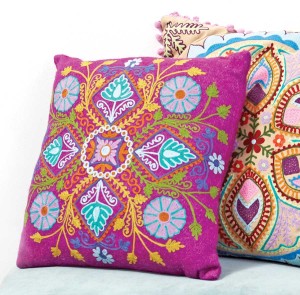
Carpets
According to Kashmiri folklore, a home is incomplete without a Kashmiri carpet, which is said to “bring the entire house together” into a unified whole. The carpet industry was introduced in the valley by Sultan Zain-ul-Abidin, the Sultan of Kashmir who brought carpet weavers from Persia and Central Asia into Kashmir to train the local inhabitants, and ever since Kashmir offers variety of carpets from hubs like Srinagar, Baramulla, Anantnag, Jammu and Leh. Kashmir exported carpets worth Rs. 231.50 crore in the first half of 2012-13 as compared to last year’s Rs. 51.02 crore, i.e. an increase of 353 per cent. “Apart from our two traditional carpet export markets like Germany and USA, with the demand for carpets rising in emerging markets like Russia, Latin American countries and Middle East, the total export of carpets which touched Rs. 455.86 crore last year is expected to see a major jump,” says Mushtaq Ahmad.
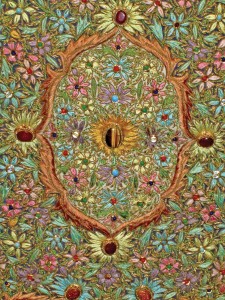
During the 1970’s and 80’s Kashmir was making only woollen carpets, but today 95% of Kashmiri carpets are in silk. The basic raw material (silk yarn) comes from Bangalore, Surat and at times from China, and wool from Kashmir. Some very fine silk carpets in different sizes are created with density of knots as high as 3600 knots per sq. inch but these are rare exhibits of skill and mainly made for display or museum pieces.
According to Showik Shaw, Proprietor, Kashmir Carpet Industries Emporium, a full length carpet measuring 6×9 feet takes anything between 7-8 months to five years in finishing. The retail prices of the silk carpet may vary anywhere from US $ 250 for a small piece ranging in size 2×3 and can go up to US $ 25,000. For a carpet ranging in size 10×14 feet would cost as much as whopping US $ 2,50,000 approximately. “Over 75% of the carpet cost goes to the weaver and his family,” claims Shaw.
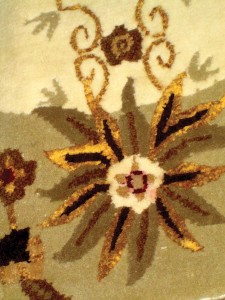
In recent times, there has been a significant upsurge of interest in orient Kashmiri hand knotted carpets and handcrafts in Europe, USA, and West Asia. Commenting on the same, Mehraj Jain, General Manger, Janson Carpets says, “Although there has been a corresponding rise in competition from China, Pakistan and Turkey, Kashmir’s rich tradition of skill, knowledge and design has made its own niche and the connoisseurs of real Kashmiri art and creativity stick to it.” His company is amongst the fastest growing manufacturing exporters in this category exporting to Germany, Switzerland, Italy, Qatar, Saudi, Bahrain, Sharjah and Dubai.
Rugs Namda, the felt rug made from beaten wool, which is then embroidered all over, is an important branch of the Kasida industry of Kashmir. Natively known as Jalakdozi, the chainstitch rugs are the specialty of Kashmir and are used both as floor coverings and wall hangings. They are manufactured economically, as the base is hessian cloth and coarse wool which are generally made from 65% wool or silk yarn and 35% cotton yarn with intricate needlework by creating a variety of traditional and modern designs and colours. The rug is supported by a cloth lining to add to the durability and comes in sizes 2×3, 3×5, 6×9 and 9×12 feet. Almost all the carpet manufacturers are producing these rugs as the international demand for it is swiftly rising.
[bleft]According to Kashmiri folklore, a home is incomplete without a Kashmiri carpet, which is said to “bring the entire house together” into a unified whole.
Kashmir exported carpets worth Rs. 231.50 crore in the first half of 2012-13 as compared to last year’s Rs. 51.02 crore, i.e. an increase of 353 per cent with the demand for carpets rising in emerging markets like Russia, Latin American and countries in the Middle East.[/bleft]
Delhi based, export house, Atsar Exports manufactures chainstitch rugs for the international markets like US, England and Germany for the last 25 years. “For us England is the biggest market as most of the houses have wooden flooring therefore they prefer these rugs, which are a good substitute for the expensive Kashmiri carpets. While cost of a carpet is around Rs. 700 per sq. feet, a chainstitch rug can cost between just Rs. 100-110 per sq. feet,” says Shafi Goroo, Proprietor, Atsar Exports. According to Shafi, the British market prefers more vibrant colours while the buyers in America prefer lighter shades. But both these markets use these rugs as floor spreads as well as wall hangings. Atsar Exports, besides exporting chainstitch rugs are also exporting wool runners, handmade hand knotted runners and papier-mâché (decorative items) products, all from Kashmir.
Catching up with the international tastes at fast pace, the Kashmir export industry in home décor is evolving rapidly and is very adaptable. Most of the Kashmiri exporters/manufacturers have opened their corporate offices outside Kashmir due to political instability in the region.
Most of these manufacturers have chosen Delhi as their market base and have setup their showrooms and offices here for the buyers’ convenience. The other factor, which makes Delhi, their preferred destination is easy access to dyeing and finishing facility which is not available in their native place.






